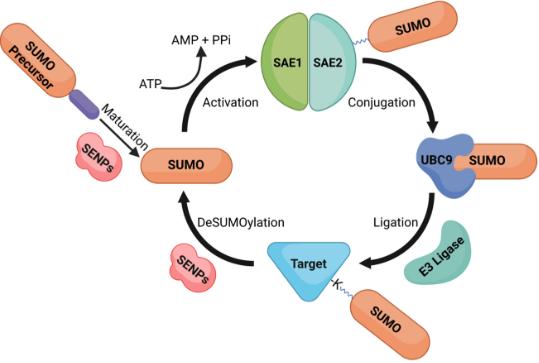SUMOylation Analysis Service
SUMOylation, a post-translational modification, involves the covalent binding of a small ubiquitin-like modifier (SUMO) to proteins. For comprehensive SUMOylation analysis services, turn to Creative Proteomics, where we excel in the identification, quantification, and characterization of protein SUMOylation modifications. These services promise valuable insights into your protein research initiatives.
What is SUMOylation
In the realm of molecular biology, SUMO proteins, classified as small ubiquitin-like modifiers, constitute a family of petite proteins resembling ubiquitin and are acknowledged as members of the ubiquitin-like protein family. SUMOylation follows an enzymatic cascade akin to that found in ubiquitination. Unlike ubiquitin, however, SUMO does not serve as a marker for proteins slated for degradation. The maturation of SUMO involves the removal of the last four amino acids from the C-terminus, facilitating the creation of an isopeptide bond between the C-terminal glycine residue of SUMO and an acceptor lysine on the target protein.

Fig.1 Schematic of SUMOylation (Mandel, N.; Agarwal, N. 2022)
SUMO proteins undergo covalent attachment or detachment from other cellular proteins through a process known as SUMOylation. While SUMOylation shares similarities with ubiquitination, its functions are distinct. While ubiquitination primarily orchestrates the enzymatic degradation of target molecules, SUMOylation takes charge of localizing and functionally regulating target molecules. This includes aspects such as protein interactions, nucleus-cytoplasmic transport, signal transduction, protein localization, transcriptional regulation, protein stability, and counteracting the effects of ubiquitination.
Applications of SUMOylation Analysis
Nuclear-Cytoplasmic Transport
Investigating how SUMOylation regulates the transport of proteins between the nucleus and the cytoplasm.
DNA Damage Response
Studying how SUMOylation influences the cellular response to DNA damage and repair mechanisms.
Protein-Protein Interactions
Understanding how SUMOylation influences protein-protein interactions and the formation of protein complexes.
Cellular Stress Responses
Investigating how SUMOylation contributes to cellular responses to various stress conditions, such as oxidative stress or heat shock.
In addition, it also has many applications such as immune response, neurodegenerative diseases, cell cycle regulation and transcriptional regulation, etc.
Our Service
Creative Proteomics has advanced protein detection technologies and can provide customized services to researchers and scientists to help them reveal the complexity of PTM using powerful mass spectrometry technologies. Our services are thoughtful and detailed and the process of SUMOylation analysis service is as follows:

Fig.2 SUMOylation analysis workflow
- Sample Preparation
Proper extraction and preparation of proteins from biological samples to ensure preservation of SUMOylated proteins. - SUMOylation Enrichment
Enrichment techniques are employed to isolate SUMOylated proteins or peptides. This step is crucial as SUMOylation modifications are often present in low abundance compared to unmodified proteins. - Detection
WB, protein microarrays and LC-MS/MS are powerful tools for the identification and quantification of SUMOylated peptides, and they provide detection information that facilitates a comprehensive analysis of SUMOylation. - Bioinformatics Analysis
Advanced bioinformatics tools are used to analyze data, identify SUMOylated peptides, and map these modifications to protein sequences. - Result Delivery
After professional data analysis, we deliver results quickly and consistently.
Creative Proteomics brings a wealth of experience to the field of protein research. Our comprehensive services and products cover the entire spectrum of utilizing suitable and efficient gateways. Utilizing our proprietary platform, we have successfully implemented many proteomics research projects. If you are interested, please contact us for more information and a quote.
Reference
- Mandel, N.; Agarwal, N. Role of Sumoylation in Neurodegenerative Diseases. Cells. 2022, 11(21): 3395

